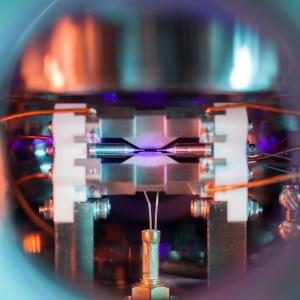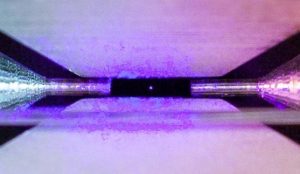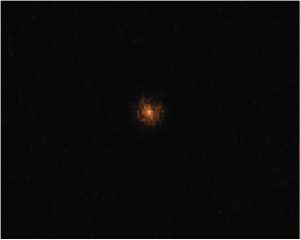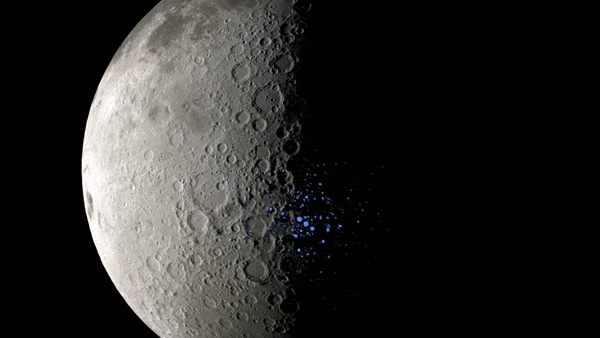This picture was awarded 1st place in a national science photography competition organized by the Engineering and Physical Sciences Research Council (EPSRC) in the UK.

Image Credit: David Nadlinger’s Blog Site
Perhaps you looked at this image and enjoyed its colourful composition, but when zoomed in, the main attraction of this photo meagrely floats between two electrodes placed only 2mm apart.

Image Credit: National Geographic
Called the ‘Single Atom in an Ion Trap’, on August 7th 2017, David Nadlinger from Oxford University was able to take this magnificent image of a single, positively charged strontium ion using only a Canon EOS 5D Mark II camera. This image was taken behind from a window of an ultra high vacuum chamber which contained the ion trap. Shone with a laser, the ion reflects a light capturable with a 30 second exposure time.
“The idea of being able to see a single atom with the naked eye had struck me as a wonderfully direct and visceral bridge between the minuscule quantum world and our macroscopic reality. A back-of-the-envelope calculation showed the numbers to be on my side, and when I set off to the lab with camera and tripods one quiet Sunday afternoon, I was rewarded with this particular picture of a small, pale blue dot.” – David Nadlinger
So, was this the first time a single atom had ever been photographed? Well, no. This feat goes back as far as 1979, when in Heidelberg, Germany, Dr. Werner Neuhauser made the first observation of an isolated atom through a lens. Using the same principles, he had seen a flickering barium ion in an electromagnetic trap, reflecting the light of a laser. Unfortunately, there is no digital record of this incident as cameras weren’t exactly “atom-friendly” 30 years ago. With DSLR cameras now being a household object, it is easy to take for granted the efficiency and availability of these products. In 1979, Canon had released the world’s first autofocus camera, the AF35M. The AF35M was a compact camera with a shutter speed range of 1/8 to 1/500 of a second, but in comparison to the camera Nadlinger had used which had a range of 30 to 1/8000, one could see how photographing an atom would not have exactly been feasible.
Similarly, a group of scientists at the University of Otago in New Zealand had also captured an image of a single, neutral rubidium-85 atom. However, a high numerical aperture aspheric lens was used in this case, which is more of a microscope than a camera.

Image Credit: University of Otago, Atom Physics Otago
Then, if this first-place photograph doesn’t bring anything new to the scientific table, what does it have to offer? Well, this image captures the culmination of many milestones in the history of scientific discovery. It starts from the conception of the notion of an atom being the smallest unit of matter, to as recent as 2012 when Dr. David Wineland was awarded the Nobel Prize in Physics for the devise of experimental methods that would allow manipulation of individual quantum systems.
Technological advancements allow us to continue expanding the forefront of science. Artificial embryos, AI, 3D printing- modern technology really is a remarkable thing! How small of a particle or how far into space could a camera another 30 years from now capture? Even those who may fully not understand the scientific aspect of Nadlinger’s set-up can still appreciate the scrupulous nature of the work that goes into isolating a single atom.
In full colour and full context, this photograph captures the attention of artists and scientists alike. Perhaps your next exciting encounter with natural phenomena will be made through the phone in your back pocket.
Julia Lee


